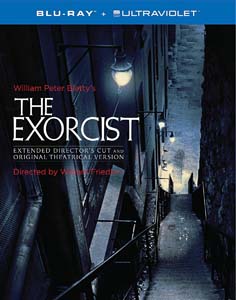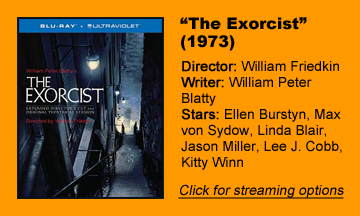It’s an excellent month for an exorcism. From Oct. 21-31, I’m looking back at the five films of “The Exorcist” series as we celebrate Spooky Month here at Reviews from My Couch. First up is “The Exorcist” (1973):
Faithful to the novel
“The Exorcist” came out long before the era when audiences demanded faithfulness to the source material – a trend that roughly started with the “Harry Potter” adaptations in 2001 – but the screenplay is very faithful to the 1971 novel. This is because both are written by William Peter Blatty.
I like the book slightly more for how it blends the warmth of the MacNeil home with slow-building dread, and because it allows for us to create the demon in our mind’s eye.
That said, I don’t know if director William Friedkin’s adaptation – which legendarily both drew and terrified huge crowds – could be much better. On this viewing, I found a beautiful ugliness to the home, but more of an overall chill to the proceedings.
Every actor plays their character in some sort of pain, be it the weight of his vocation (Max von Sydow’s Father Merrin), existential self-doubt (Jason Miller’s Father Karras), the fear and helplessness of having a sick child (Ellen Burstyn’s Chris MacNeil), or physical pain (Linda Blair’s young, demon-possessed Regan).
The three house workers in the MacNeil home are almost like family in the book, but here they are drone-like symbols of a society that can’t help Chris when she really needs it. I think of “Exorcist II: The Heretic” as the movie filled with medical lab machinery, but the original has a lot of it, too.
Chill of the unknown
It’s easy to forget today, but the idea of possession and the ritual of an exorcism were not mainstream topics (even in storytelling) in 1973. The chill of the unknown may have waned with time, but Burstyn’s harried performance drives this pseudo-mystery where we know the answer.
One thing the original cut could use more of is creepiness, but that’s nicely rectified in the 2000 director’s cut with a single shot: Regan spider-walking down the stairs to interrupt the wrap party for her actress mom’s film. Combined with the subsequent shot of Regan peeing on the carpet and making an out-of-character threat (something that’s in both versions), a viewer gets zapped out of the pleasant lull of the film to that point.
The stage is set for the most memorable part of “The Exorcist,” which is both creepy and amusing to me, when Regan is tied to the bed in her room, possessed by Pazuzu.
On this viewing, I felt bad for Blair. For a little kid to be in demon makeup and spew pea-soup vomit is a lot to ask, let alone being jerked about on the bed with such force that she was injured at one point. It probably wouldn’t happen today.
Granted, an older stunt double shared the burden, and indeed, Regan/Pazuzu is a master class in creating an amalgam out of acting, makeup, dubbed and manipulated voices, and animal sound effects. It’s also unintentionally funnier than the book, because we can clearly see that this isn’t a mental illness. So it’s amusing how long it takes everyone to figure out Regan is possessed by a demon.
Emphasis on Karras
“The Exorcist” is a dual-focus story, though, and the emphasis on Karras surprises me on every viewing. Miller looks sort of like Harry Dean Stanton from “Alien,” all of his years showing on his face, and then some.
The exorcists are the heroes of the story, without question, but Blatty also shows the extreme cost of this job. We’re told that Merrin nearly died performing an exorcism that lasted months.
With Karras, it’s more about the steep price of this whole lifestyle, including the vow of poverty; his elderly mom spends her final days in a crappy government hospital, as Karras can’t afford anything better.
A church-employed psychiatrist, he’s supplied with a ratty dorm at Georgetown University despite holding a laundry list of medical degrees from top schools. His lifestyle stands in stark contrast to that of movie star Chris, who employs a cook, maid and butler right down the street.
Urban dirtiness
Even though there is a certain (appropriate) ugliness to the film under the lens of Owen Roizman, the lived-in, urban sense of place is delicious. A prime example is the stone staircase not far from Regan’s second-story bedroom. They lead from this block to the block below, and are now known in the real world as “the ‘Exorcist’ steps.”
One could nitpick little leaps in logic and threads that could be connected better. I’m unclear if Merrin accidentally resurrected Pazuzu. And it’s odd that the murder of Burke Dennings (Jack MacGowran), Chris’ director, happens off screen and through explanation from police detective Kinderman (Lee J. Cobb). But the mood and momentum is not hampered much by these skimmed-over elements.
“The Exorcist” is on the short list of 1970s movies that impact film and culture to this day. And it’s on an even shorter list of such movies that totally hold up on a rewatch.
Schedule of “Exorcist” reviews:
Wednesday, Oct. 21: “The Exorcist” (1973)
Friday, Oct. 23: “Exorcist II: The Heretic” (1977)
Wednesday, Oct. 28: “The Exorcist III” (1990)
Friday, Oct. 30: “Exorcist: The Beginning” (2004)
Saturday, Oct. 31: “Dominion: Prequel to The Exorcist” (2005)



